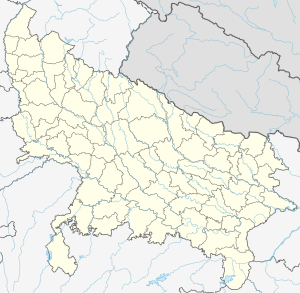Kalinjar
| Kalinjar Fort | |
|---|---|
| Part of Banda district | |
| Uttar Pradesh, India | |

A view of Kalinjar Fort
|
|
| Coordinates | 24°59′59″N 80°29′07″E / 24.9997°N 80.4852°E |
| Type | Fort, Caves & Temples |
| Site information | |
| Controlled by | Government of Uttar Pradesh |
| Open to the public |
Yes |
| Condition | Ruined Citadel |
| Site history | |
| Built | 10th century |
| Materials | Granite Stones |
| Battles/wars | Mahmud of Ghazni 1023, Sher Shah Suri 1545, British 1812 & Revolt of 1857 |
| Garrison information | |
| Past commanders |
Chandel dynasty of Rajputs & Solankis of Rewa |
| Garrison | British garrison 1947 |
 
|
Kalinjar (Hindi: कालिंजर) is a fortress-city in the Baghelkhand region of central India. Kalinjar is located in Banda District of Uttar Pradesh state, near the temple-city and World Heritage Site of Khajuraho. The fortress is strategically located on an isolated rocky hill at the end the Vindhya Range, at an elevation of 1,203 feet (367 m) and overlooks the plains of Bundelkhand. It served several of Bundelkhand's ruling dynasties, including the Chandela dynasty of Rajputs in the 10th century, and the Solankis of Rewa. The fortress contains several temples dating as far back as the Gupta dynasty of the 3rd-5th centuries.
Kalinjar means The destroyer of time in Sanskrit. 'Kal' is time and 'jar' destruction. Legend says that after manthan Hindu God, Lord Shiva, drank the poison and his throat became blue (hence the name Neel (blue) Kantha (throat)) and he came to Kalinjar and overcome the 'Kal' i.e. he achieved victory over death. This is the reason the Shiva temple at Kalinjar is called Neelkanth. Since then, the hill has been considered a holy site, casting its shadow across the patches of grasslands as well as the densely forested valley. The natural splendor of the surroundings makes it an ideal place for penance and meditation and, surprisingly, a strange mystique still pervades all over the hill.
The term "Kalinjar" (as "Kalanjara") appears in ancient Hindu mythology, but the exact origins of the fort itself are uncertain. According to the 16th century Persian historian Firishta, the town of Kalinjar was established by one Kedar Raja in 7th century. The fort came to prominence during the Chandela rule. According to Chandela-era legends, the fort was built by a Chandela ruler. The Chandela rulers used the title Kalanjaradhipati ("Lord of Kalanjara"), which shows the importance they attached to the fort.
...
Wikipedia

